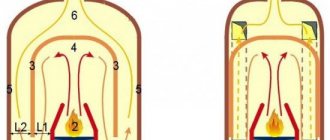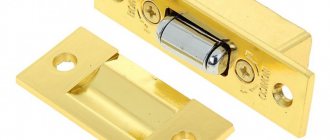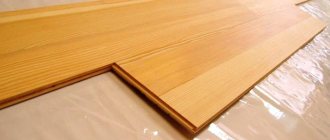The market offers a wide range of different doors. But sometimes it is difficult to choose a model that fully meets the owner’s needs. There are plenty of reasons - a significant difference in dimensions (block/opening), low quality products, poor external design, high cost, and so on. For a person who is familiar with household tools, making interior doors with your own hands is not a problem. In many cases, this solution is the most rational.
Features and models
Entrance doors are installed both in apartments and in private houses.
Regardless of the location of this structure, its direct purpose is considered to be reliable protection of housing from cold, noise and burglary. Therefore, when choosing this or that front door model, you need to take into account many nuances. Recently, homemade structures made of metal and wood have become extremely popular, while metal doors are distinguished by their functionality and design features; they are resistant to explosions, burglaries, fireproof and bulletproof. Today there are many types of entrance doors. According to their purpose they are:
- Fireproof and bulletproof. Such products are made of high-strength metal. In addition, these types of doors are additionally treated with reinforcing compounds.
- Shockproof. They are the most reliable option for protecting your home.
- Soundproofing. Prevents noise and sounds from entering the house.
- Sealed. Often installed in outbuildings.
Entrance doors can open in different ways. There are swing and sliding models of structures. In addition, doors are classified by the number of leaves and are:
- Single leaf. Made from solid fabric.
- One and a half. They are a structure consisting of two parts, where only one opens.
- Bivalve. Large doors with two opening leaves.
All entrance doors differ in appearance and shape, so a distinction is made between rectangular and arched products. Designs with a blind transom are also popular.
Installation of an insulated wooden entrance door
Models designed for installation from the street can withstand temperature changes and retain their original characteristics and appearance throughout their entire service life. In addition to the fact that insulated wooden doors do not allow heat to pass through, modern processing technologies ensure a long service life of such structures.
A wooden entrance door has the following advantages:
- minimal heat loss - due to the low thermal conductivity of wood and the presence of a layer of insulation, the optimal temperature is maintained in the house, saving money on heating costs;
- no condensation - there is no large temperature difference on the door surface. And the absence of moisture on the door leaf and on the wall allows you to increase their service life;
- good sound insulation;
- beautiful appearance.
Insulated door structure
Modern technologies make it possible to create high-quality and reliable wooden doors. They are installed both at the entrance to the house and to the apartment. An insulated wooden door consists of the following elements:
- frame - made of solid wood or wooden blocks;
- insulation - applied to the outside or inside of the finished door, and covered with decorative material on top of it. In wooden houses, the insulation on the door is covered with slats. There are factory options, when a layer of insulation is placed inside the door. If the door is framed independently, then the insulation is spread between sheets of chipboard or MDF;
seal - attached around the perimeter of the canvas or box, or in both places at once. This is done with glue, double-sided tape or furniture nails. The thickness of the seal must correspond to the gap between the frame and the door leaf, so it is selected individually in each case. - The seal ensures a tight fit of the leaf to the door frame
A small lunge is made on the door leaves to close the gap between the frame and the leaf.
Frame
Such doors have only a wooden frame. And inside it is filled with sawdust, shavings, chips or cardboard. Fiberboard panels are attached to the frame itself on top. How to do it:
- Prepare the board elements for the frame and two sheets of fiberboard of the required size.
- Fasten the frame with self-tapping screws and lay the first sheet of fiberboard on top. Attach it with nails or pins.
- You turn the entire structure over and fill the voids of the frame.
- Lay the second sheet and attach it to the frame.
- Final decorative finishing
Frame door in the process of assembly
Classification of insulation
The construction market offers the following types of insulation:
- Felt is processed animal wool. It has excellent properties to retain heat and is absolutely safe for human or animal health.
- Polystyrene foam - it is sold in sheets. Easily cut and fixed on the door leaf. Does not slip, does not absorb moisture. It is both insulation and soundproofing material. Can only be used for insulating metal doors. When installing foam plastic, the gaps are closed with mounting foam or using liquid nails.
- Foam rubber is a soft material. The main disadvantage of this material is that if it is used to insulate a wooden street door (private house), it will soon crumble due to temperature changes. Foam rubber is produced either in rolls or in sheets.
- Mineral wool is a soft insulation with positive characteristics. It has high thermal insulation properties and also creates sound insulation. The material has its drawbacks - moisture absorption. If you insulate the door from the street side, then you need to use polyethylene. When moisture is absorbed by the cotton wool, the door will become heavy, which will lead to deformation and improper operation of the door leaf.
- Isolon is sold in rolls. One of the most expensive materials. The base of the insulation is foamed polyethylene. The disadvantage of this material is the pricing policy. But, given his qualities, this can not be taken into account.
- Polyurethane foam is foam that can be pumped into the door cavity. The hardening time is less than a day. The only drawback of this material is that it is not possible to pump the foam yourself. You should call the experts who will do this carefully and quickly. The insulation retains heat, creates silence, and is not poisonous.
Selecting insulation thickness
The thickness of the material depends on the size of the door. Let’s say if the door is empty inside, then you should simply put insulation there and cover it with the top layer of the door leaf.
If the door does not have voids, then you need to stuff an additional frame on the inside of the door, which is filled with material and then sewn up with upholstery (leather substitute). The nuance here is the fact that the thickness of the insulation should not exceed the thickness of the door leaf.
Installation
First, install the box using polyurethane foam. After hardening, begin installing the canvas. For wooden structures, it is better to choose removable hinges. They can withstand heavy weight and are easy to install. Such hinges are suitable for a barn door, entrance or interior structure.
Adjustment
If the door cannot be closed due to the frame being skewed, you should remove the panel and check the joints of the beams. An angle of 90° must be maintained. If necessary, the box is corrected. When hinges become the cause, the attachment point is deepened or completely changed. The last option is suitable when there is no way to correct the current location of the loops.
What type of wood to choose
One of the most critical stages is the choice of source material. Each type of wood is endowed with special mechanical and physical qualities. It is necessary to know the features of different types in order to determine which one is ideal for solving a particular problem. All wood can be divided into two categories - deciduous and coniferous.
Hardwood
This series contains the most valuable species, endowed with extraordinary strength, high density, expressive texture and attractive natural shades.
Wood has the highest value:
- beech;
- nut;
- mahogany.
If there is no reason to spend money on expensive raw materials, you can get by with more affordable ones. Pay attention to the advantages:
- cherries;
- oak;
- ash
These rocks also have high strength, but will not require such significant costs as representatives of the first category.
Oak wood is very durable and resistant to rotting. Due to the content of tannins, which react with dyes during etching, it allows you to achieve intense color effects. Processing the material is not difficult - it lends itself well to simple tools. Making parts of unusual, curved shapes from it is not a problem.
Ash is as hard and durable as oak. However, this material requires regular treatment with antiseptic compounds. Otherwise, when the first wet season arrives, it will begin to rot.
Conifers
Coniferous wood never loses its popularity. This is explained by its availability and a wide range of positive qualities. The most popular materials are those made from pine, followed by spruce.
The strength characteristics of pine are slightly lower than those of deciduous trees. This disadvantage is more than offset by high resistance to biodegradation, mold and mildew, excellent thermal conductivity and extraordinary flexibility during processing. High air and moisture permeability guarantees decent quality of treatment with protective compounds.
Spruce is more susceptible to rotting compared to pine, but has less hygroscopicity and thermal conductivity. Products made from this material retain their original shape much longer.
If you choose between these two species, you should give preference to pine.
Deciduous tree wood is ideal for making interior doors. And for entrance structures, pine would be the best choice.
Types of doors by design
Doors are classified according to various criteria - the design of the door leaf, the method of opening.
The following types of door leaves are distinguished:
- massive;
- paneled;
- panel;
Groups of door structures by opening method
- hinged - with one or two doors;
- sliding – so-called compartments, equipped with a guide system;
- folding - doors resemble an accordion or a book;
- radial.
To make wooden doors, boards, beams, and furniture panels are used. To decide on the choice of material, you need to understand the pros and cons of each of them. Let's look at the characteristics of the various options.
Massive doors
To make doors from solid wood, planed or grooved boards of large thickness are suitable. The latter are convenient because they are easily combined into a single fabric without forming cracks. This becomes possible thanks to the locking system, which consists of a longitudinal protrusion and a corresponding slot on the edges of the board. The canvas, made up of boards, is fastened with transverse or diagonal jumpers.
When making a front door, you should give preference to more expensive breeds. Oak, larch or cedar are suitable. For outbuildings, budget options are quite suitable - pine, linden or spruce.
Panel doors
This is a separate category of doors with its own design features. Their canvases consist of a frame and rectangular inserts - panels.
The main load-bearing element of this structure is the frame, which is otherwise called the frame. The remaining elements are attached to it - wooden inserts. The harness is usually made from solid wood. Glued laminated timber will also work. Four parts connected to each other form a frame. The bottom element is wider than the top and side panels. This provides the structure with additional strength. You can further strengthen the bottom of the door by covering it with sheet metal. Galvanized steel or aluminum will do. This is especially true for strengthening entrance panels.
No less important elements are the transverse strips - in other words - the middle ones. They are bars that are attached horizontally in the middle of the future canvas.
And finally, the details that gave the name to the entire structure - panels. These fragments are inserted into the frame, resulting in the formation of a single piece. Special grooves are provided for their installation. The panels are attached using a tongue-and-groove system or decorative beads, which allow you to quickly and without damaging the door replace the damaged element. Panels can be made from chipboard, MDF, plywood and even glass. They are installed in the door frame, and in addition to their main purpose, they also have a decorative function. They are given interesting shapes and decorated with carvings or paintings.
Panel doors
The design of the panel door is much simpler than the previous version. It consists of a box and the main part - the shield itself. Fiberboard, veneer or laminate are suitable for making the box. The frame is first made from boards. It is advisable to use sheets of chipboard, MDF or fiberboard as a shield.
Panel sheets can be:
- solid - made from interconnected bars;
- hollow - a frame of connected beams is sheathed with lamellas;
- small-hollow - have a variety of fillings, for example, honeycomb.
Tools
In production, special machines are used to make wooden doors.
- Thicknesser is necessary for processing the board. The most productive are double-sided planing machines, which clean the workpiece in one pass.
- without milling machine . It is used to make locking joints on boards, select chamfers, and process shaped workpieces.
- When gluing overlays to a wooden frame, a press .
- a circular saw to cut the board to the desired size.
To make wooden interior doors with your own hands at home, no one will buy expensive machines. circular saw is suitable for cutting the boards .
You can select grooves and process the surface of the workpieces using a hand router .
Additionally, you should have on hand:
- drill;
- screwdriver;
- wood hacksaw;
- grinder;
- chisels, mallet, corner, level, tape measure.
To paint the door leaf, it is advisable to use a compressor with an air gun.
Requirements for entrance doors
Entrance doors that can be installed in a country house must have the following qualities:
- low thermal conductivity;
- resistance to the negative effects of environmental factors;
- resistance to mechanical loads;
- attractive appearance;
- reliability of fittings;
- affordable price of production materials and, as a result, low cost of the finished product.
Now we know what wooden entrance doors can be made with our own hands, it remains to find out what materials these products can be assembled from.
Re-sheathing
Before you figure out how to insulate an iron door with your own hands, you need to think about the exterior finishing. We're talking about upholstery. So, leatherette or leather substitute is perfect for these purposes. Next we do this:
- We lay the material on the door.
- We cut off the canvas, leaving a margin of 10-20 centimeters on each side.
- Fold leatherette or leatherette beautifully.
- Secure with special decorative nails.
- We return hinges and fittings
Once the door is insulated and finished, we return the hinges and fittings to their places. To do everything right, it is better to photograph their location in advance. It is better to choose new handles - to match the color and style of the new design.
Preparation stage
Personally designing or assembling something requires careful analysis of many factors and selection of the most appropriate option.
Material
Considering the organization of production at home, the best option is wooden doors. There are interior models on sale made from different materials - plastics, glass, aluminum - but working with them requires not only experience, but also special tools. In addition, wood has an undeniable advantage - it is able to “breathe”, which has a beneficial effect on the microclimate in the house.
Engineering solution
Interior doors are divided into several types - hinged, folding, sliding (compartment). The models also differ in design - single-leaf, double-leaf, and one-and-a-half-leaf. Some of them have an upper extension - a transom. What is it advisable to focus on? Without professional skills, special tools, or machine equipment, you should choose a swing interior door with one leaf.
These are the most popular varieties installed inside apartments and private houses. If you study the step-by-step instructions for constructing doors of all types, then it is the swing “one-room doors” that are easier to manufacture. In addition, preparing the opening for their installation does not require complex technological operations.
Blade type
- Paneled. The advantage of interior doors in this category is their relatively light weight. The canvases consist of a wooden frame and inserts, which differ in size, material, and shape. The difficulty is that the panels will have to be fixed to it, and for this you need to select quarters in the tree. Even with professional tools (equipment) at hand, independent production of interior doors of this type (if we mean quality) is a big question. To achieve the desired result, you will have to spend a lot of time and material, the consumption of which will be significant, since the volume of rejection will increase.
- Shield. This solution is optimal. The only downside is the weight. But this problem can also be solved if you choose boards of small thickness. Since we are talking about interior doors and not entrance doors, the strength of the door leaf is not a primary factor. But there are many more advantages: ease of assembly, the possibility of any finishing (varnishing, tinting, brushing, lining with plastic, decorative film, natural veneer - different design styles are practiced), high maintainability.
In addition, the door dampens noise well and is characterized by low thermal conductivity. There is another factor that many people overlook. Wood is prone to deformation (it “plays” under the influence of changes in humidity and temperature in the house). A solid door is less susceptible to this than a paneled model, especially if the inserts are made of a different material. For example, glass, plastic.
Lumber
- The type of wood does not play a big role if subsequent finishing of the canvas and frame is planned. You can partially save on this by choosing inexpensive products. But if you decide to make a door from boards while maintaining their texture, then the answer to the question of what to buy is obvious.
- Degree of wood drying. According to SNiP, lumber with a moisture content exceeding 22% cannot be used in construction. When applied to doors, experts advise focusing on 10 - 12. Wet wood will shrink and the structure will “lead.” If the samples are thoroughly dried, then, firstly, they will cost more, and secondly, there will be difficulties with cutting them. In addition, excessively dry wood easily splits, and this will cause problems with fastening fittings and inserting locking devices.
Varieties and dimensions
- Frame. A beam with a side of 40 - 50 mm is sufficient for the frame of the canvas. It is necessary to take into account the installation location of the door, that is, how intensively it will be used. Plus - the specifics of the room at the entrance to which it is installed; Is the door supposed to be equipped with a lock, and if so, what type. The latter fully applies to canopies.
- Canvas. To reduce the weight of the interior door and facilitate the manufacturing process, it is advisable to use MDF for covering the frame. Another argument in favor of this solution is that the slab material (if it is of high quality and carefully processed) is inert to humidity and temperature. If you want to make a door from solid wood, 10 boards with a width of 150 are suitable.
- Box Rarely does anyone leave an old joint in place. If a new door is being assembled, it must be completely complete. When choosing timber, you need to take into account the thickness of the wall (partition) at the installation site. There is no other recommendation for this item other than sufficient strength of the jamb.
The choice of material is largely determined by the door drawing. The interior door leaf is made in different ways; it can be solid, hollow or “cellular”. The last option is called small-hollow.
Door diagram
- Dimensions. The initial data for calculations are the dimensions of the opening. For accuracy of calculations, its width is measured at 3 levels; similarly with height - at three points (on the sides and in the center). It is worth considering that a technological gap of 4±1 mm is left between it and the box around the perimeter. This is the outer contour of the jamb. Provided that the width of the canvas is of decisive importance, then everything else is calculated based on its required dimensions. In this case, the gap between it and the jamb (within 1 mm) is also taken into account.
In practice, it is difficult to make wooden doors with your own hands, without experience, in exact accordance with the specified values, but it is advisable to adhere to these values. And the main thing is the correct shape (rectangle) of the door frame. The slightest curvatures, distortions - and problems with a tight fit of the canvas are guaranteed.
- The direction of opening the canvas. When determining it, the location of the opening in the room is taken into account; The pictures explain this well.
Do-it-yourself wooden door: step-by-step instructions
Having dealt with the tools, we proceed to the step-by-step creation of a solid wood structure. Next, we’ll look at the simplest option, how to make wooden doors with your own hands (video).
Preparing the boards
The future canvas should be smooth and beautiful, so before making a wooden door with your own hands, sand the purchased boards. Put a circle on the grinder, turn on the equipment and walk along the wide surfaces of the boards. The ends do not require such processing.
Milling
If you don’t have a machine, a hand tool and a set of cutters with it are quite suitable for making wooden doors with your own hands. The treatment needs to be done just at the ends of the wooden boards. You should go around the corners, slightly rounding them. The main thing is not to overdo it and not remove them completely. Select a suitable cutter, take a long board and make a groove along the entire length of the end. It should pass clearly through the center of the end, and the depth should be no more than 2 cm.
Trimming the ends of the boards
Using a circular hand saw, the ends of the four main boards should be cut at a 45-degree angle. To get a clear angle, use a protractor. The length of the stand must be 2 meters. If the height of the future structure should be of a different size, then everything can be selected individually.
We cut fiberboard
If you have chosen the material of the desired size, then you will not have to cut it. If it is larger than the required standard, then, before making a door from fiberboard with your own hands, cut according to the following scheme: from the width of the door leaf, subtract twice the width of the prepared boards, and then add two depths of the cut groove to the value.
Test assembly of the structure
So, we make wooden doors with our own hands. We take the prepared fiberboard element and put boards on it. Next, we connect all the other parts of the fiberboard door with our own hands, without glue for now. The main thing is to make sure that the elements fit and are in place. When everything is as it should be, mechanical fasteners are installed. At the same stage, you should decide on the fittings and prepare a place for them.
Interior systems can have different designs:
- Panel. A paneled wooden door is created with your own hands using the designer method: the frame is made of thick wood, inside which a thinner panel is inserted. In order for the canvas to fit into the base, grooves are made in the base, and the materials are secured at the joints with glue. Sometimes paneled doors are created not from a single piece, but from glued parts.
- Sliding structures. It is based on a wooden frame, thin fabric, which is upholstered with other materials.
- With glass inserts. It consists of a base into which glass is inserted (it can be of various shapes, textures and sizes). The glass is fixed with glazing beads and inserted into the grooves.
How to insulate?
One of the purposes of the entrance structure is considered to be good thermal insulation, so the canvas should be well insulated. Various technologies are used for this. If the box is made of metal, then first of all you need to fill its internal unused cavity. In this case, it is filled with a special insulating material in the form of mineral wool or polystyrene foam. Also, to keep the door warm, it can be covered with wooden beams. The only drawback of this technology is the formation of cold bridges.
The front door is well insulated with dermantine. With this technology, the door leaf is upholstered on only one side, and a thin layer of insulation is applied to two openings. Thermal insulation is glued directly to the door, and then it is decorated with dermantine or genuine leather.
Equally important is protecting the structure from drafts. There are two ways to do this:
- Insulating the gaps between the frame and the canvas. A rubber or foam seal works well as thermal insulation. It is attached using a self-adhesive base and applied both to the box itself and to the canvas.
- Opening the door frame. The outer and inner sides of the slopes are upholstered, and the gaps between the opening and the structure are filled with insulating material.
If none of the types of thermal insulation are suitable, an alternative solution may be to install a second entrance door.
New door trim
The next step will be upholstery of the prepared wooden doors. For this purpose, you can use soft materials such as leather substitute or dermantine. The upholstery fabric is cut with a margin of at least 10 cm in length and width. This is necessary for hemming the material, which should have some thickening around the entire perimeter of the door leaf.
Dermantin can be used as a finishing material
It is best to attach dermantine to special nails. They have a large decorative cap, which gives the trim a more attractive look. You can also run copper wire along the nails. If you pull it, you get an additional fastening for both insulation and exterior finishing.
An analogue of soft materials is MDF. This type of finishing is used for frame panels. In this case, each panel is attached to a clamp and nailed along the perimeter.
How to weld awnings?
Before installing the entrance doors, it is necessary to weld the hinges (canopies). As a rule, to hold a standard structure you will need two hinges, the distance between them should not exceed 20 cm. Before work begins, the canopies are thoroughly cleaned and treated with a special solution. It is advisable to weld the hinges horizontally in relation to the door frame. In the event that the opening is already installed, the welding seam is carried out vertically.
The hinges are welded according to the following scheme:
- The prepared blanks are divided into two components, one of which is welded to the canvas, and the second to the box.
- First, the lower loop is attached, it is welded in several places.
- The location of the loop is checked using a building level.
- A final check is being carried out.
As for the upper hinge, the work on its installation is carried out in the same way; the only thing worth considering is the location of both canopies in the same plane. They must be placed clearly on top of each other. At the end of the work, it is important to thoroughly clean the seams from plaque, then weld the fittings themselves.
How to treat wood
Now we need to make the structure resistant to various external factors - atmosphere, moisture, cold. At this stage, it acquires not only reliability, but also its complete individual appearance.
Coloring
Preparation for painting begins with sanding. You need to sand in the direction along the grain. Then treat the surface with an antiseptic. Dents and chips should be filled with putty. As you apply the putty, you need to let it dry and then sand it again.
Before painting, you need to clean the surface from dust. To obtain a high-quality painted door, apply 2-3 layers of paint and avoid smudges.
Cladding with decorative panels
Decorative panels for cladding can be made of plastic, siding, veneer, laminate and other materials. They are solid massive canvases. They are mounted on a wooden surface using glue or self-tapping screws.
Eliminating gaps using a sealant
When choosing how to insulate a wooden entrance door, you should not ignore different types of sealing elements, but to determine the best one, it is better to consult with the seller. Seals are specially designed products whose function is to maximally fill the gaps and cracks between the door elements: the frame and the wooden leaf. In addition to thermal protection, the insulation serves as soundproofing for the entrance door to an apartment or house.
Installing a seal and sealing reduces the overall heat loss through a wooden door, solving the insulation issue by about 60%.
Types intended for wooden doors
To insulate wooden entrance doors, different types of doorway seals are used:
- tubular made of porous rubber;
- silicone;
- foam rubber.
There are options for attaching the seal: to the adhesive layer applied by the manufacturer or using small nails with your own hands. When choosing sealing strips for a wooden door, you should take into account the performance characteristics and durability of the material. The best choice is a rubber seal.
Features of operation
When buying an entrance door, it is important to pay attention to what materials it is made of and how high quality it is. And if the door is installed correctly, then during its operation it remains to adhere to the following recommendations:
- protect from rain and direct sunlight by installing a canopy over it;
- monitor the integrity of the surface. If damage occurs, restoration work must be carried out immediately. If the damage is serious, you will have to turn to restorers, but even this will be cheaper than buying a new door;
- properly care for the door: periodically wipe off dust, stains and other contaminants (depending on the type of door covering). This can be done in several ways: with a 10% alcohol solution;
- water;
- soap solution.
Dimensions
Before you begin work on the manufacture of the entrance structure, you should first determine the dimensions of the future product and correctly measure the doorway. It is worth paying attention to the fact that in each apartment or house the dimensions of the openings may differ. If you plan to install a standard single-leaf door, then you will need leaves 860x2050 mm or 960x2050 mm.
What to do if the wood is swollen?
Many novice carpenters use wet boards when making doors or perform these operations in a damp room. In this case, the wood picks up moisture and begins to increase in size, which will render the door leaf itself unusable in the future. Therefore, before starting work, you must thoroughly dry the boards, but without using powerful hair dryers.
The best option would be special drying or fresh air (in the shade).
If the door begins to swell after its installation, then this situation can be corrected in several ways:
- First of all, you need to create a normal temperature and minimum humidity in the room. After some time, the boards may dry out and “return” to their place.
- If the structure cannot be restored, then you should try to reinstall or adjust the hinges so that the canvas fits easily into the box.
- The most common option is to change its shape using a plane. To do this, the place where the canvas does not close is slightly undercut. Sometimes you can perform such an operation not only with the door, but also with the frame itself. But it is advisable to remove a minimum layer, since the wood may dry out over time and cracks will form in these places.
- Forced drying of the door leaf. But this operation should be performed only at low temperatures and for a long time. If this is done abruptly, then cracks will simply appear on the boards and the door will become unusable.
Dowel assembly
The simplest door option. Suitable for utility rooms or baths and saunas.
- Cut the boards to the required length
- Lay out the leaf of the future door on a flat surface
- Fix the position of the blade
- Make dowels (crossbars that will hold the entire frame of the door leaf together)
- Using a router, make recesses for the keys
- Install the keys into the grooves and secure them with self-tapping screws
- Next is final sanding of the door leaf, treatment with antiseptic and paint.
Door assembled with dowels
How to avoid mistakes?
To prevent unforeseen situations from taking you by surprise, you must:
- take correct measurements;
- create a drawing of an object;
- carefully measure angles and parallels;
- adjust the frame and canvas;
- treat materials with protective compounds.
Making a front door takes time and patience. Only by carefully following all the recommendations can you achieve a good result. Accuracy is important in the work, so you need to measure the doorway in several places. If it is uneven, it should be strengthened with cement mortar.
Preparatory work
To insulate the door leaf, you should go step by step, stage by stage. This approach allows you to achieve good results and eliminate errors. And first there is preparatory work to be done.
To ensure that nothing interferes with the work, you need to remove the door leaf. This is done using a mounting tool or a nail puller. It is enough to pry the canvas from below and it will rise from its hinges. If the rotary axis is slightly rusty, then it must be lubricated with machine oil. After this, with small forward movements you can move the hinge and remove the door leaf.
When the door is outside the frame, all existing elements must be removed from it. The hinges, handles, peephole and lock are carefully unscrewed and put aside. If the door is not made only of wood, then it is necessary to remove the sheet of inner lining to gain access to the interior of the door leaf.
Reviews
If you install a good wooden entrance door made of solid wood on ridges, and not a paneled one for 1200 rubles, and cover it 5 times with a good varnish, and not some crap “Pinotex”, then you won’t have to bother with any metal . Besides, what is the point of installing a metal door in a wooden house? If they don’t open the door, they’ll cut out a piece of the wall and climb in (as one of my friends did at her dacha).
Sources
- https://USA-dba.ru/sdelat-tpluyu-dver-svoimi-rukami/
- https://legkovmeste.ru/stroitelstvo-i-remont/dveri/dveri-vhodnyie-derevyannyie-uteplennyie.html
- https://odstroy.ru/dveri-vhodnye-derevannye-uteplennye-kak-sdelat-samostoatelno/
- https://roomester.ru/dekor/dveri/derevyannaya-dver-svoimi-rukami.html
- https://gorodverey.ru/derevyannaya-dver-svoimi-rukami-chertezhi.html
- https://BestDoor.guru/izgotovlenie/mezhkomnatnye-dveri-svoimi-rukami.html
- https://dveri365.house/po-materialam/derevyannye/derevyannaya-dver-svoimi-rukami.html
- https://dekoriko.ru/dveri/vhodnye/svoimi-rukami-kak-sdelat/
- https://vitdoors.ru/dveri/poshagovaya-instrukciya-izgotovleniya-derevyannoy-dveri-svoimi-rukami-kakie-instrumenty-potrebuyutsya-7.html
- https://ODveryah.ru/uluchshenie/uteplit-vhodnuyu-derevyannuyu-dver-svoimi-rukami-v-chastnom-dome
- https://stroy-podskazka.ru/dveri/mezhkomnatnye/izgotovlenie-derevyannoy/
- https://VseoDveri.ru/vhodnye-dveri/vhodnaya-dver-svoimi-rukami/











